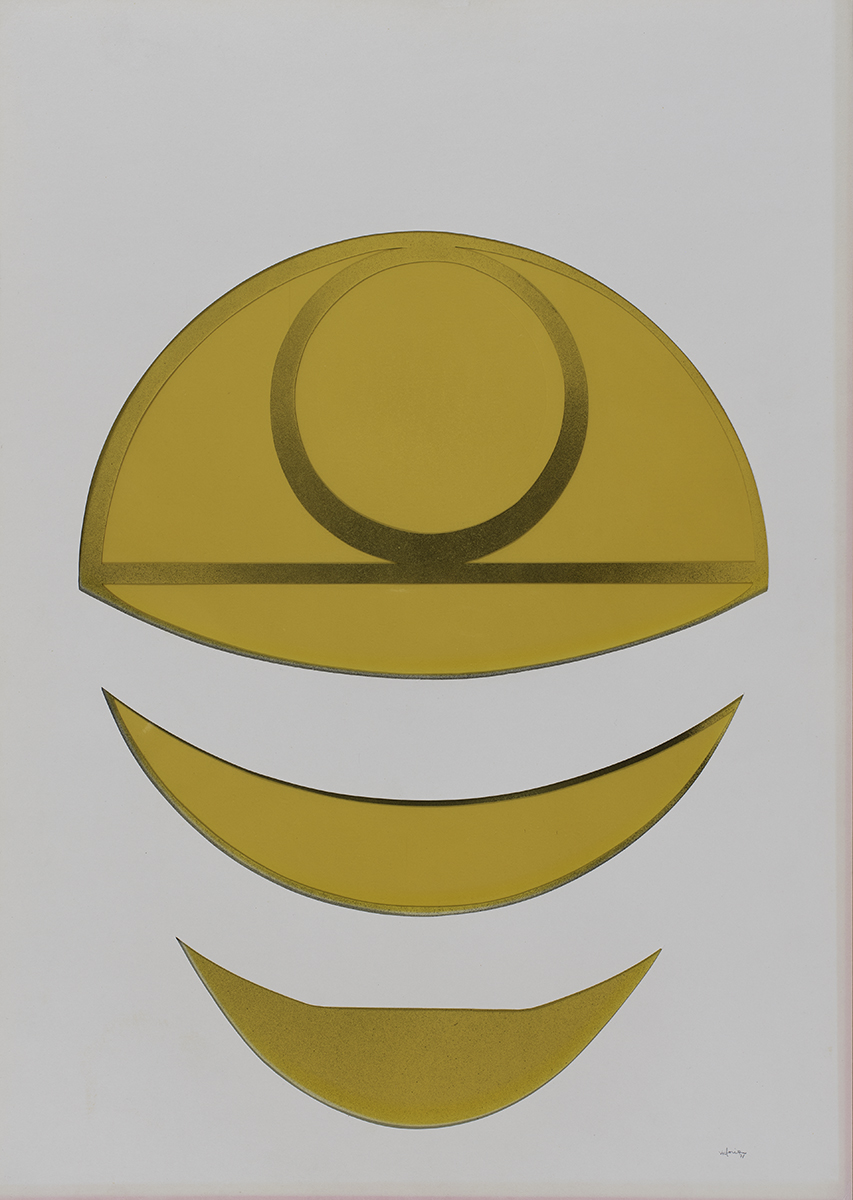At the end of 1964 Salvador Victoria returned to Spain after spending ten years in Paris. And so he brought to an end a highly fruitful period that had acquainted him intimately with international avant-garde movements. Worth underscoring is his knowledge of the work and thinking of two artists who would be critical for his later practice: Wassily Kandinsky (1866-1944)—particularly his study of geometric forms and his connection with the cosmic—and Paul Klee (1879-1940) and his treatment of light, motifs and spiritual conception of art. At that time, Victoria had already taken part in significant European events, including the 30th Venice Biennale (1960) and the 2nd Paris Biennale (1961) held at the Musée d´Art Moderne de la Ville de Paris.
After arriving in Madrid he joined the roster of the recently opened Galería Juana Mordó. In 1965 he held his first solo exhibitions in Spain, organised at the Ateneo in Madrid and the Museum of Fine Arts of Bilbao. From that moment onwards he would exhibit his work on a regular basis for many years.
In his works from this time he began to organise the space with an evident influence from

an art and architecture movement born in 1914 in Russia which became known particularly after the October Revolution. The movement defends an active engagement of the artwork with its surrounding space. The term was first used by Kazimir Malevich (1878-1935) in 1917 to contemptuously describe a work by Aleksander Rodchenko (1891-1956) and it did not have a positive connotation until the
Realist Manifesto from 1920.
. In the 1970s his works had already left behind the

Term coined by the French art critic Michel Tapié (under the name of art informel) to define the art movement that covers a whole range of abstract and gestural trends that emerged in Europe in the 1940s in parallel with the development of

This contemporary painting movement emerged within the field of abstraction in the 1940s in the United States, from where it spread worldwide. Rooted in similar premises and postulates as Surrealism, the Abstract Expressionist artists regarded the act of painting as a spontaneous and unconscious activity, a dynamic bodily action divested of any kind of prior planning. The works belonging to this movement are defined by the use of pure, vibrant primary colours that convey a profound sense of freedom. The movement’s main pioneers were, among others, Arshile Gorky (1904-1948) and Hans Hoffman (1880-1966). Leading Spanish exponents of the movement are Esteban Vicente (1903-2001) and José Guerrero (1914-1991), who lived for some time in New York City, where they were in first-hand contact with the many artistic innovations taking place there around that time.
in America. The movement is defined by a non-figurative language that lends a very significant role to the use of materials. The defining moment for Informalismo in Spain was in the 1950s, with a generation of artists whose languages embraced both European Art Informel and American

This contemporary painting movement emerged within the field of abstraction in the 1940s in the United States, from where it spread worldwide. Rooted in similar premises and postulates as Surrealism, the Abstract Expressionist artists regarded the act of painting as a spontaneous and unconscious activity, a dynamic bodily action divested of any kind of prior planning. The works belonging to this movement are defined by the use of pure, vibrant primary colours that convey a profound sense of freedom. The movement’s main pioneers were, among others, Arshile Gorky (1904-1948) and Hans Hoffman (1880-1966). Leading Spanish exponents of the movement are Esteban Vicente (1903-2001) and José Guerrero (1914-1991), who lived for some time in New York City, where they were in first-hand contact with the many artistic innovations taking place there around that time.
. These included, among others, Antoni Tàpies (1923-2012), Josep Guinovart (1927-2007), August Puig (1929-1999), Antonio Saura (1930-1998), Manolo Millares (1926-1972) and Rafael Canogar (1935).
of his Paris period and were now dominated by the forcefulness of geometric forms, especially the circle. Victoria was a serious-minded artist who conscientiously studied the visual qualities of his creations. The arrangement of the bodies in space, the harmony of colours and the suggestion of texture are key aspects in his practice.
Victoria had been using the technique of

A technique in the visual arts consisting of gluing materials likes photographs, bits of wood, leather, newspapers and magazine clippings or other objects to a piece of paper, canvas, or other surface. Collage became widely popular in the early twentieth century thanks to Cubist painters, and it is still in use today as yet another artistic medium.
since the 1960s to experiment with relief. Colour plays a decisive role in his collages, made on paper and board. His palette softened and acquired a strong light, something in which many critics detect the influence of the Valencian Post-Impressionism that marked his formative years.
In the works the artist called
superposiciones (overlayerings) he took the volumetric potential offered by

A technique in the visual arts consisting of gluing materials likes photographs, bits of wood, leather, newspapers and magazine clippings or other objects to a piece of paper, canvas, or other surface. Collage became widely popular in the early twentieth century thanks to Cubist painters, and it is still in use today as yet another artistic medium.
to its maximum. He accurately and minutely built up layers of poster board die-cut by hand, placing acetates between them to increase the sensation of relief. Besides, he applied paint using

A technique in which paint is applied by nebulisation on a surface. The tool employed is the airbrush, and the resulting effect is very similar to painting with spray.
to reinforce the impression that the bodies are floating in an undetermined space. As seen in other examples of
superposiciones in the BBVA Collection, the exploration he began in pieces like this would give rise to later developments and to greater complexity of forms and volumes.









